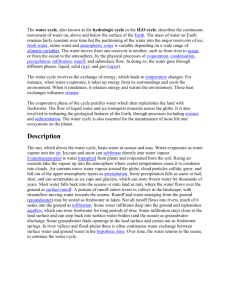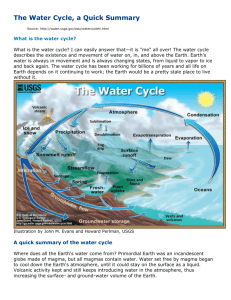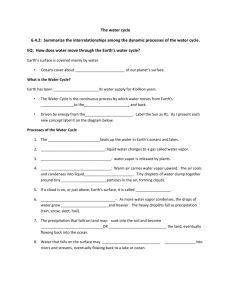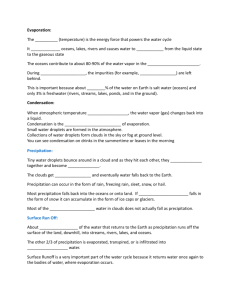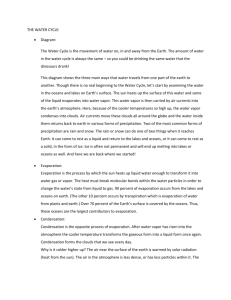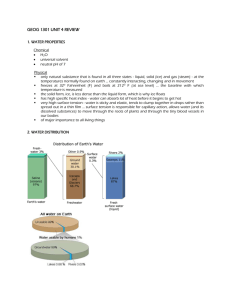The water cycle.
advertisement
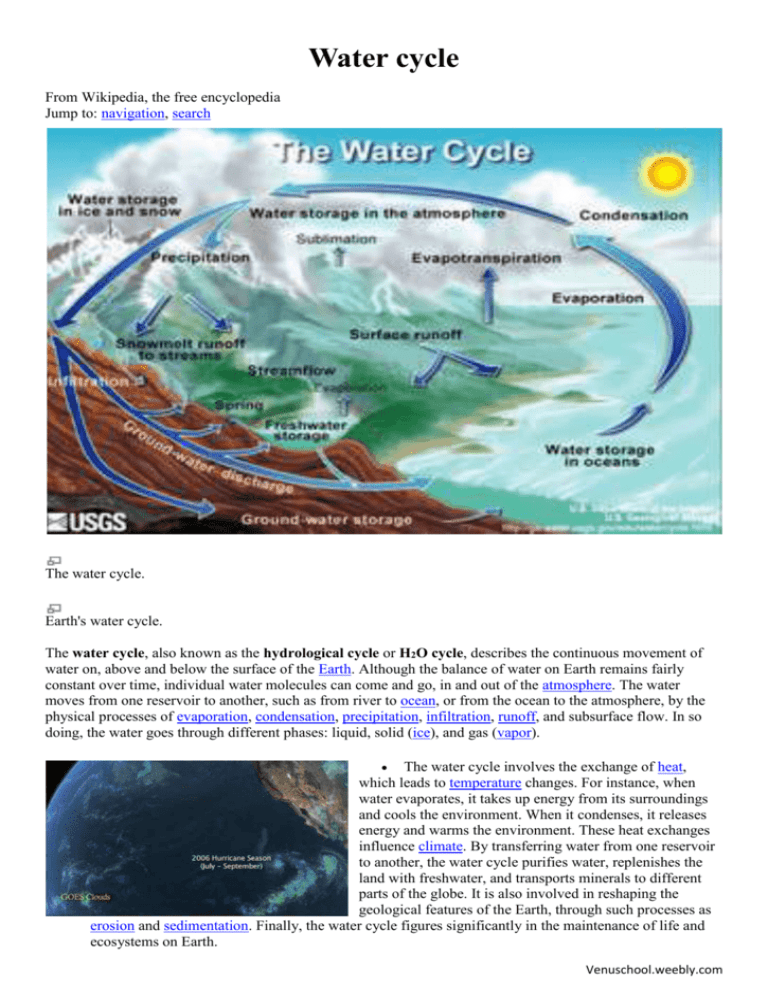
Water cycle From Wikipedia, the free encyclopedia Jump to: navigation, search The water cycle. Earth's water cycle. The water cycle, also known as the hydrological cycle or H2O cycle, describes the continuous movement of water on, above and below the surface of the Earth. Although the balance of water on Earth remains fairly constant over time, individual water molecules can come and go, in and out of the atmosphere. The water moves from one reservoir to another, such as from river to ocean, or from the ocean to the atmosphere, by the physical processes of evaporation, condensation, precipitation, infiltration, runoff, and subsurface flow. In so doing, the water goes through different phases: liquid, solid (ice), and gas (vapor). The water cycle involves the exchange of heat, which leads to temperature changes. For instance, when water evaporates, it takes up energy from its surroundings and cools the environment. When it condenses, it releases energy and warms the environment. These heat exchanges influence climate. By transferring water from one reservoir to another, the water cycle purifies water, replenishes the land with freshwater, and transports minerals to different parts of the globe. It is also involved in reshaping the geological features of the Earth, through such processes as erosion and sedimentation. Finally, the water cycle figures significantly in the maintenance of life and ecosystems on Earth. Venuschool.weebly.com As the Earth's surface water evaporates, winds move water in the air from the sea to the land, increasing the amount of fresh water on land. Water vapor is converted to clouds that bring fresh water to land in the form of rain or snow. Precipitation falls on the ground, but what happens to that water depends greatly on the geography of the land at any particular place. Description The Sun, which drives the water cycle, heats water in oceans and seas. Water evaporates as water vapor into the air. Ice and snow can sublimate directly into water vapor. Evapotranspiration is water transpired from plants and evaporated from the soil. Rising air currents take the vapor up into the atmosphere where cooler temperatures cause it to condense into clouds. Air currents move water vapor around the globe, cloud particles collide, grow, and fall out of the upper atmospheric layers as precipitation. Some precipitation falls as snow or hail, sleet, and can accumulate as ice caps and glaciers, which can store frozen water for thousands of years. Most water falls back into the oceans or onto land as rain, where the water flows over the ground as surface runoff. A portion of runoff enters rivers in valleys in the landscape, with streamflow moving water towards the oceans. Runoff and groundwater are stored as freshwater in lakes. Not all runoff flows into rivers, much of it soaks into the ground as infiltration. Some water infiltrates deep into the ground and replenishes aquifers, which store freshwater for long periods of time. Some infiltration stays close to the land surface and can seep back into surface-water bodies (and the ocean) as groundwater discharge. Some groundwater finds openings in the land surface and comes out as freshwater springs. Over time, the water returns to the ocean, where our water cycle started. Venuschool.weebly.com Processes Many different processes lead to movements and phase changes in water Precipitation Condensed water vapor that falls to the Earth's surface . Most precipitation occurs as rain, but also includes snow, hail, fog drip, graupel, and sleet.[1] Approximately 505,000 km3 (121,000 cu mi) of water falls as precipitation each year, 398,000 km3 (95,000 cu mi) of it over the oceans.[2] Canopy interception The precipitation that is intercepted by plant foliage, eventually evaporates back to the atmosphere rather than falling to the ground. Snowmelt The runoff produced by melting snow. Runoff The variety of ways by which water moves across the land. This includes both surface runoff and channel runoff. As it flows, the water may seep into the ground, evaporate into the air, become stored in lakes or reservoirs, or be extracted for agricultural or other human uses. Infiltration The flow of water from the ground surface into the ground. Once infiltrated, the water becomes soil moisture or groundwater.[3] Subsurface flow The flow of water underground, in the vadose zone and aquifers. Subsurface water may return to the surface (e.g. as a spring or by being pumped) or eventually seep into the oceans. Water returns to the land surface at lower elevation than where it infiltrated, under the force of gravity or gravity induced pressures. Groundwater tends to move slowly, and is replenished slowly, so it can remain in aquifers for thousands of years. Evaporation The transformation of water from liquid to gas phases as it moves from the ground or bodies of water into the overlying atmosphere.[4] The source of energy for evaporation is primarily solar radiation. Evaporation often implicitly includes transpiration from plants, though together they are specifically referred to as evapotranspiration. Total annual evapotranspiration amounts to approximately 505,000 km3 (121,000 cu mi) of water, 434,000 km3 (104,000 cu mi) of which evaporates from the oceans.[2] Sublimation The state change directly from solid water (snow or ice) to water vapor.[5] Deposition This refers to changing of water vapor directly to ice. Advection The movement of water — in solid, liquid, or vapor states — through the atmosphere. Without advection, water that evaporated over the oceans could not precipitate over land.[6] Venuschool.weebly.com Condensation The transformation of water vapor to liquid water droplets in the air, creating clouds and fog.[7] Transpiration The release of water vapor from plants and soil into the air. Water vapor is a gas that cannot be seen. Percolation Water flows horizontally through the soil and rocks under the influence of gravity Residence times Average reservoir residence times[8] Reservoir Average residence time Antarctica 20,000 years Oceans 3,200 years Glaciers 20 to 100 years Seasonal snow cover 2 to 6 months Soil moisture 1 to 2 months Groundwater: shallow 100 to 200 years Groundwater: deep 10,000 years Lakes (see lake retention time) 50 to 100 years Rivers 2 to 6 months Atmosphere 9 days The residence time of a reservoir within the hydrologic cycle is the average time a water molecule will spend in that reservoir (see adjacent table). It is a measure of the average age of the water in that reservoir. Groundwater can spend over 10,000 years beneath Earth's surface before leaving. Particularly old groundwater is called fossil water. Water stored in the soil remains there very briefly, because it is spread thinly across the Earth, and is readily lost by evaporation, transpiration, stream flow, or groundwater recharge. After evaporating, the residence time in the atmosphere is about 9 days before condensing and falling to the Earth as precipitation. The major ice sheets - Antarctica and Greenland - store ice for very long periods. Ice from Antarctica has been reliably dated to 800,000 years before present, though the average residence time is shorter.[9] In hydrology, residence times can be estimated in two ways. The more common method relies on the principle of conservation of mass and assumes the amount of water in a given reservoir is roughly constant. With this method, residence times are estimated by dividing the volume of the reservoir by the rate by which water either enters or exits the reservoir. Conceptually, this is equivalent to timing how long it would take the reservoir to become filled from empty if no water were to leave (or how long it would take the reservoir to empty from full if no water were to enter). An alternative method to estimate residence times, which is gaining in popularity for dating groundwater, is the use of isotopic techniques. This is done in the subfield of isotope hydrology. Changes over time The water cycle describes the processes that drive the movement of water throughout the hydrosphere. However, much more water is "in storage" for long periods of time than is actually moving through the cycle. The storehouses for the vast majority of all water on Earth are the oceans. It is estimated that of the 332,500,000 mi3 (1,386,000,000 km3) of the world's water supply, about 321,000,000 mi3 (1,338,000,000 km3) is stored in oceans, or about 97%. It is also estimated that the oceans supply about 90% of the evaporated water that goes into the water cycle.[10] Venuschool.weebly.com During colder climatic periods more ice caps and glaciers form, and enough of the global water supply accumulates as ice to lessen the amounts in other parts of the water cycle. The reverse is true during warm periods. During the last ice age glaciers covered almost one-third of Earth's land mass, with the result being that the oceans were about 400 ft (122 m) lower than today. During the last global "warm spell," about 125,000 years ago, the seas were about 18 ft (5.5 m) higher than they are now. About three million years ago the oceans could have been up to 165 ft (50 m) higher.[10] The scientific consensus expressed in the 2007 Intergovernmental Panel on Climate Change (IPCC) Summary for Policymakers[11] is for the water cycle to continue to intensify throughout the 21st century, though this does not mean that precipitation will increase in all regions. In subtropical land areas — places that are already relatively dry — precipitation is projected to decrease during the 21st century, increasing the probability of drought. The drying is projected to be strongest near the poleward margins of the subtropics (for example, the Mediterranean Basin, South Africa, southern Australia, and the Southwestern United States). Annual precipitation amounts are expected to increase in near-equatorial regions that tend to be wet in the present climate, and also at high latitudes. These large-scale patterns are present in nearly all of the climate model simulations conducted at several international research centers as part of the 4th Assessment of the IPCC. There is now ample evidence that increased hydrologic variability and change in climate has and will continue to have a profound impact on the water sector through the hydrologic cycle, water availability, water demand, and water allocation at the global, regional, basin, and local levels.[12] Research published in 2012 in Science based on surface ocean salinity over the period 1950 to 2000 confirm this projection of an intensified global water cycle with salty areas becoming more saline and fresher areas becoming more fresh over the period:[13] Fundamental thermodynamics and climate models suggest that dry regions will become drier and wet regions will become wetter in response to warming. Efforts to detect this long-term response in sparse surface observations of rainfall and evaporation remain ambiguous. We show that ocean salinity patterns express an identifiable fingerprint of an intensifying water cycle. Our 50-year observed global surface salinity changes, combined with changes from global climate models, present robust evidence of an intensified global water cycle at a rate of 8 ± 5% per degree of surface warming. This rate is double the response projected by currentgeneration climate models and suggests that a substantial (16 to 24%) intensification of the global water cycle will occur in a future 2° to 3° warmer world.[14] An instrument carried by the SAC-D satellite launched in June, 2011 measures global sea surface salinity but data collection began only in June, 2011.[15][13] Glacial retreat is also an example of a changing water cycle, where the supply of water to glaciers from precipitation cannot keep up with the loss of water from melting and sublimation. Glacial retreat since 1850 has been extensive.[16] Human activities that alter the water cycle include: agriculture industry alteration of the chemical composition of the atmosphere construction of dams deforestation and afforestation removal of groundwater from wells water abstraction from rivers urbanization Effects on climate The water cycle is powered from solar energy. 86% of the global evaporation occurs from the oceans, reducing their temperature by evaporative cooling. Without the cooling, the effect of evaporation on the greenhouse effect would lead to a much higher surface temperature of 67 °C (153 °F), and a warmer planet.[17] Venuschool.weebly.com Aquifer drawdown or overdrafting and the pumping of fossil water increases the total amount of water in the hydrosphere, and has been postulated to be a contributor to sea-level rise.[18] Effects on biogeochemical cycling While the water cycle is itself a biogeochemical cycle,[19] flow of water over and beneath the Earth is a key component of the cycling of other biogeochemicals. Runoff is responsible for almost all of the transport of eroded sediment and phosphorus[20] from land to waterbodies. The salinity of the oceans is derived from erosion and transport of dissolved salts from the land. Cultural eutrophication of lakes is primarily due to phosphorus, applied in excess to agricultural fields in fertilizers, and then transported overland and down rivers. Both runoff and groundwater flow play significant roles in transporting nitrogen from the land to waterbodies.[21] The dead zone at the outlet of the Mississippi River is a consequence of nitrates from fertilizer being carried off agricultural fields and funnelled down the river system to the Gulf of Mexico. Runoff also plays a part in the carbon cycle, again through the transport of eroded rock and soil.[22] Venuschool.weebly.com


